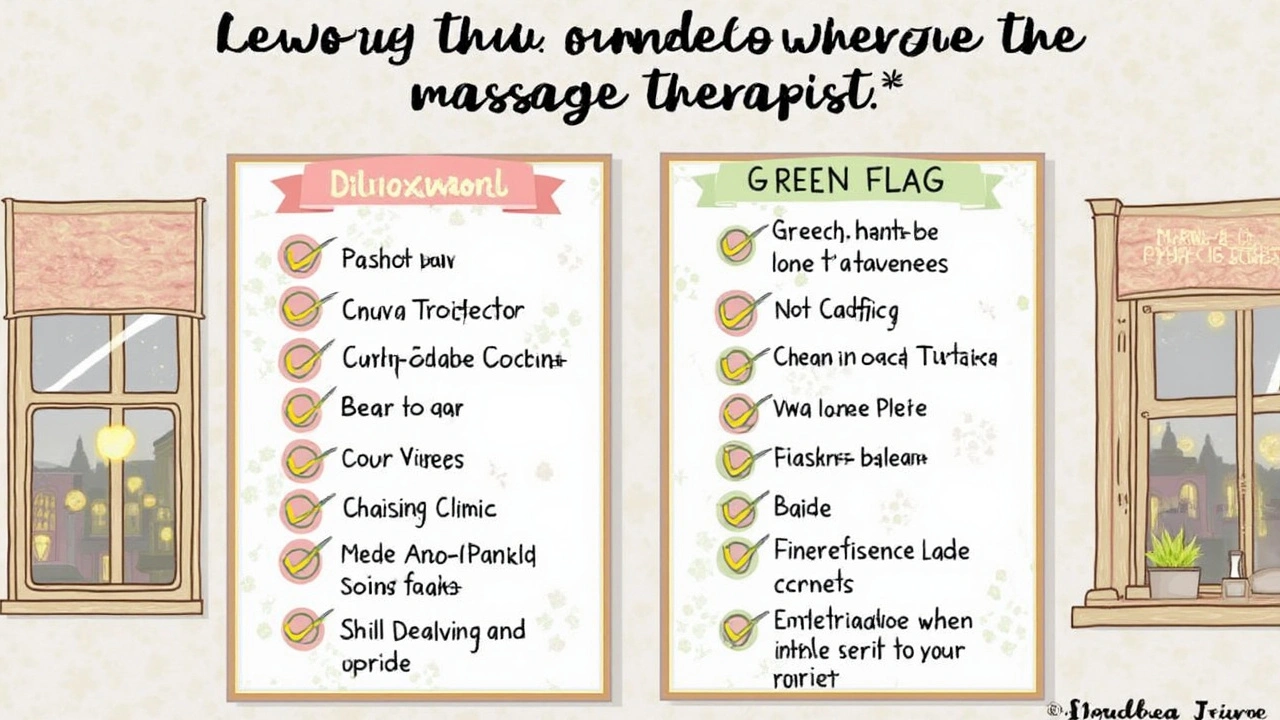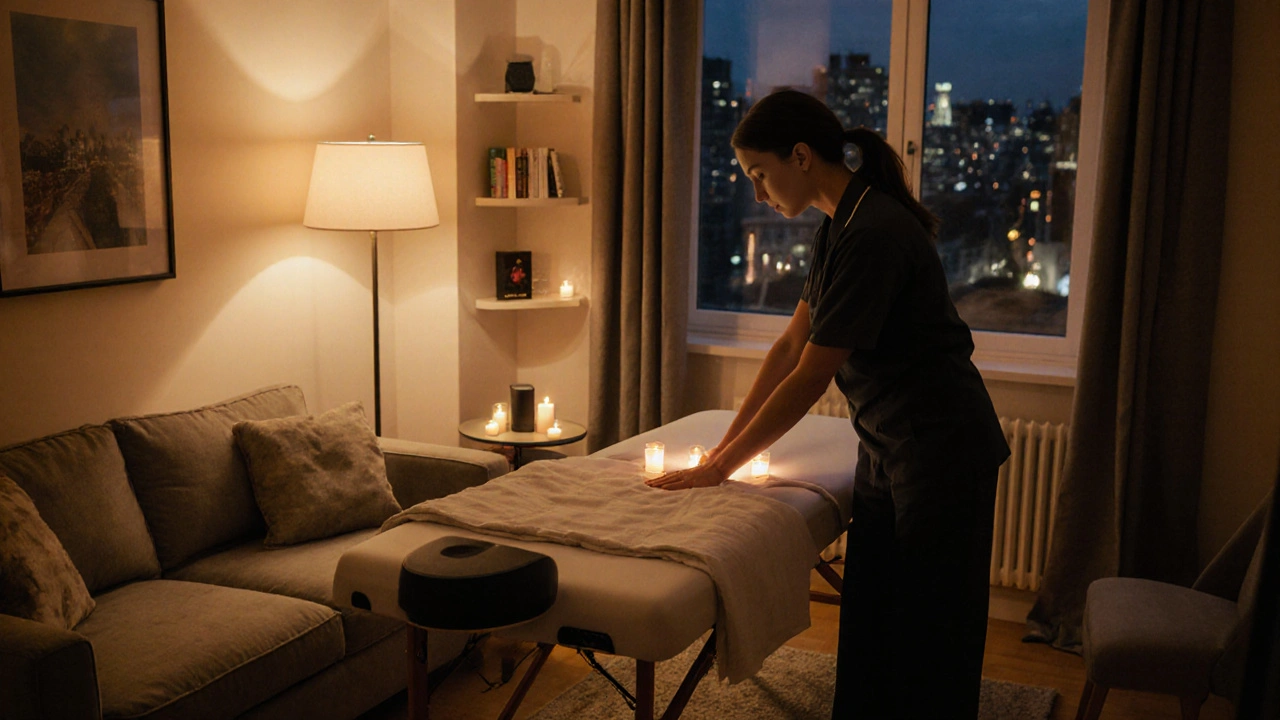If you’ve ever walked past a window advertising Thai massage and wondered, 'How do I pick a therapist who actually knows their stuff?', you’re not alone. The difference between a refreshing massage and a disappointing one often comes down to who’s giving it.
Not all Thai massage therapists are created equal. Some are trained in ancient techniques passed down for generations; others might just be winging it after a weekend class. Ever notice how much better you feel after a treatment with a therapist who understands your needs? That's not luck—it’s skill.
Finding the right Thai massage therapist isn’t just about picking the nearest place or the cheapest price. It's about making sure you get the relief, flexibility, and good vibes you’re after. There are legit tips you can use to cut through the clutter and avoid wasted time or money (or worse, an awkward experience).
- Key Takeaways & Quick Answers
- Why Picking the Right Therapist Matters
- Thai Massage Basics & Benefits
- Exploring Different Thai Massage Styles
- What to Watch For and How to Book Safely
- FAQs & Next Steps
Key Takeaways & Quick Answers
If you're trying to figure out how to pick the right thai massage therapist, here's what you really need to know without the fluff.
- Look for legit training: Ask where your therapist trained. Reputable therapists usually have certificates from recognized Thai massage schools. It's not rude—it's smart.
- Specialties matter: Not every therapist does every style. Some focus on stretching, others on relaxation, and a few might be pros at deep tissue work. Pick the style that matches what your body needs.
- Check reviews: Real feedback from people who've actually had a massage says a lot. Google, TripAdvisor, and even local Facebook groups can spill the tea on who's great and who to avoid.
- Safety first: A good therapist respects your comfort. If anything feels sketchy during a session, you have the right to end it, no questions asked.
- Price isn't always equal to quality: Cheap can be risky but pricey doesn't always guarantee expertise. Compare services and experience, not just numbers.
| What to Ask | Why It Matters |
|---|---|
| Training & Certification? | Makes sure techniques are safe and authentic |
| Type of Thai Massage? | Some are gentle, some are more intense—get what fits you |
| Session Customization? | Ensures they adapt to your needs, not a one-size-fits-all |
Bottom line: take a little time to check skills, read real reviews, and ask questions before booking. It pays off—in relaxation and peace of mind.
Why Picking the Right Therapist Matters
Ever left a massage feeling more tense than when you walked in? The truth is, not every therapist will click with your needs. Picking the right thai massage therapist can make all the difference between walking out relaxed and pain-free, or feeling like you wasted your cash.
Thai massage isn’t just about pressing or stretching muscles. It’s a mix of science and tradition, using pressure points, joint mobilization, and even guided stretching. The right therapist understands human anatomy, listens to you, and knows how to adjust their pressure—too much, and you’ll be sore; too little, and you might as well have stayed home.
There’s actual data showing skilled therapists reduce pain, improve mobility, and even help with stress-related issues. According to a 2022 client survey from a Bangkok wellness group, customers who reported strong therapist-client communication had a 40% greater chance of long-term positive results. The right fit isn’t just nice to have—it’s what makes the treatment work.
Here’s what you get when you pick wisely:
- Better understanding of your health goals—whether you want relief from back pain or just some stress melted away.
- Low risk of injury. A trained pro knows how to avoid aggravating existing conditions or causing new ones.
- A massage tailored to you. No cookie-cutter routines—just a session that feels totally personalized.
- Clear communication before and during the session, so you’re never guessing what happens next.
Take your time to find someone you’re comfortable with. Checking reviews, verifying credentials, and even doing a quick intro call can save you from a bad experience. It’s not about being picky—it’s about getting the most from every session.
Thai Massage Basics & Benefits
Thai massage isn’t just another spa treatment—it’s hands-on therapy dating back more than 2,500 years. Unlike your typical Western massage (think oil and rubbing), Thai massage combines stretching, acupressure, and a unique kind of body movement. You’re usually fully clothed, lying on a firm mat, while the therapist uses not just their hands but sometimes elbows, knees, and even feet to get knots out and loosen up stiff spots.
The main goal here isn’t just relaxation; it’s about restoring the body’s balance and boosting your flexibility. Some folks call it “lazy person’s yoga,” since you get the stretching and benefits without moving a muscle yourself. A lot of therapists will focus on major energy lines, or 'Sen lines,' similar to the concept of meridians in Chinese medicine.
So, what does this all mean for you? Here’s what people notice after regular Thai massage treatments:
- Better flexibility—you’ll notice it in your neck, shoulders, and hips after just a session or two.
- Relief from muscle and joint pain, especially if you’re hunched over a desk most of the day.
- Lower stress—most people walk away feeling lighter and a bit more chilled out.
- Improved circulation, which is key for people with tense muscles or that “heavy leg” feeling.
- A little more energy—don’t be surprised if you feel less sluggish and more focused.
Research backs up a lot of these perks. A study published in the "Journal of Bodywork and Movement Therapies" found that Thai massage led to “significant reduction in back and leg pain” for office workers. Even athletes use it for recovery between hard training sessions.
In a nutshell, if you’re after more than just a quick rub down, and you want to walk out standing taller and moving smoother, thai massage therapist skills matter a lot for the full effect. Getting someone who knows how to do these movements safely is key to actually seeing all those benefits.

Exploring Different Thai Massage Styles
Diving into Thai massage, you’ll soon notice there isn’t a one-size-fits-all approach. Every style has its own rhythm, pressure, and focus area, so it pays to know what’s out there before you book. A little background goes a long way if you want your session to actually fit your needs.
The classic or traditional style—sometimes called “Nuad Thai”—is what most people expect when they think of Thai massage. This is the style recognized by UNESCO as part of the world’s cultural heritage. You usually stay clothed, and the therapist guides you through stretches, using their hands, elbows, knees, and sometimes even their feet. It feels a bit like someone turning you into a human pretzel, in the best way. This method is great for flexibility, energy flow, and post-workout soreness.
Then there’s “Thai Oil Massage.” Instead of the dry, yoga-like stretches, this one uses oils and is more similar to Swedish massage in some ways. The moves are slower and more relaxing. Thai oil massage is perfect if you want relaxation, lighter pressure, and less stretching. Great for winding down after a stressful week.
If deep muscle relief is what you’re after, “Deep Tissue Thai Massage” takes things up a notch. It still uses some traditional stretches, but the focus is more on working out those stubborn knots and tension points. People recovering from intense workouts or sitting all day at a desk love this style.
For those looking for something even more specialized, some therapists offer “Tok Sen.” This is a Northern Thai method using a wooden hammer and mallet—yes, really. Gentle tapping is believed to help move energy, break up muscle tension, and ease chronic pain. It sounds unusual, but regulars swear by it.
Some places offer blends, like combining Thai and Swedish techniques. If you’re unsure what you want, don’t be afraid to ask. Many therapists can tweak the session based on your feedback and comfort.
If you like numbers, check this quick chart comparing the popular Thai massage styles:
| Style | Main Features | Who It’s For |
|---|---|---|
| Traditional Thai | Clothed, deep stretches, pressure points | Anyone wanting flexibility, energy balance |
| Oil Thai Massage | Oils used, gentle strokes, relaxing | People who want to relax, lighter touch |
| Deep Tissue Thai | Strong pressure, muscle focus | Active people, muscle soreness |
| Tok Sen | Wooden mallet tapping, unique method | Chronic pain, energy flow issues |
The best move? Talk to your thai massage therapist about what you want to get out of your session. That way, you’ll land on the right style for your goals—without any guesswork.
What to Watch For and How to Book Safely
Nothing ruins a good massage faster than walking into a place and realizing it doesn’t meet even your basic standards. If you want a great thai massage therapist who actually helps you feel better, here’s what you should look out for—and how to book without stress.
First up, always check for proper credentials. In Thailand, legitimate therapists often hold a certificate from the Thai Ministry of Health, but worldwide, look for professional training, basic anatomy knowledge, and real client reviews. If you can’t find their info online, that’s a red flag. A reputable therapist won’t hesitate to share their qualifications or answer your questions if you ask before booking.
Pay attention to hygiene and the general vibe of the space. Is the studio clean? Are towels and linens fresh? No legit place should ever ask you to reuse towels from a previous client. Sometimes, trusting your first impression is key—if something doesn’t feel right, just leave.
Here are some tips for booking a session safely:
- Book through the official website or recognized booking platforms, not through random DMs or unofficial links.
- Read recent reviews (not just the glowing ones from last year—look for trends).
- Ask what’s included in the service, how long it lasts, and if there are any extra fees.
- Be upfront about your health conditions and injuries, so the therapist can tailor the massage (or tell you if you should avoid certain techniques).
- If you’re new, ask if you can meet the therapist ahead of time or have a short chat—this helps you feel at ease and makes sure you click.
One simple thing people forget: pay attention to how the therapist and staff talk to you. If they pressure you, dodge basic questions, or act annoyed when you ask for clarification, that's a huge warning sign.
Here’s a quick table to help spot red and green flags before booking:
| Red Flag | Green Flag |
|---|---|
| No clear license or credentials displayed | Credentials and certifications shown in plain sight |
| Poor or no reviews, bad hygiene | Consistent good reviews, clean facilities |
| Vague price info, hidden fees | Transparent, upfront pricing and service menu |
| Pressure to pay or book quickly | Respectful communication, no pressure |
Last but not least, never pay the full amount upfront, especially if it’s your first visit. Most places only ask for a small deposit, if anything. Keep your personal info safe; you shouldn’t have to give away ID or sensitive details just to book.
FAQs & Next Steps
Got questions about picking your ideal Thai massage therapist? You're not alone. It's easy to get lost with all the info out there, so let's clear up some real concerns folks have before booking their first session—or jumping to a new spot.
- How do I know if a Thai massage therapist is qualified? Check if they display a license or certification. Many good therapists train at places like Wat Pho in Bangkok, which is basically the Harvard of Thai massage schools. If in doubt, ask about their experience or see if reviews mention their skills.
- Do I need to bring or wear anything special? Comfortable clothes are best, since traditional Thai massage happens with you fully clothed. Loose pants and a t-shirt work. Some places provide clothes, but it's fine to bring your own.
- How much should I expect to pay? Thai massage prices usually range from $40–$90 per hour in most U.S. cities, but it can be higher or lower depending on the area. If the price is way below average, maybe think twice—that's often a red flag for untrained therapists.
- Is Thai massage supposed to hurt? You’ll feel deep stretching, but it shouldn’t actually hurt. Always tell your therapist if pressure feels like too much. A skilled thai massage therapist knows how to read your body cues and will switch it up if needed.
- What’s the etiquette for tipping? Tipping is pretty standard—usually 15–20%, just like other wellness services. Some spas include gratuity in the bill, so double-check.
Feeling a bit more confident now? Here’s what you should do next if you’re ready to book:
- Read reviews: Look for recent, specific feedback—not just star ratings, but comments about the therapist's style and professionalism.
- Ask questions before booking: Don’t be shy! Call or message the therapist/spa and ask about their experience and training.
- Check hygiene and professionalism: A clean, organized space is a good sign. If you walk in and things look messy, go somewhere else.
- Listen to your gut: If anything feels off in the first few minutes, it’s okay to leave or ask for another therapist.
| Step | Action | Why It Matters |
|---|---|---|
| 1 | Read reviews | Real feedback from past clients shows the therapist's true skills. |
| 2 | Ask about training | Ensures you’re getting someone with solid background, not a rookie. |
| 3 | Visit the spa | Clean spaces usually mean better standards and care. |
| 4 | Pay attention to comfort | Your gut rarely lies—if you feel uneasy, trust that feeling. |
Ready for your next massage? Pick a therapist who checks all your boxes and set up that session. You deserve to feel good, not stressed about your choice. Still not sure? Try a 30-minute starter session—no shame in testing the waters before you dive in for the full 90-minute treatment.


